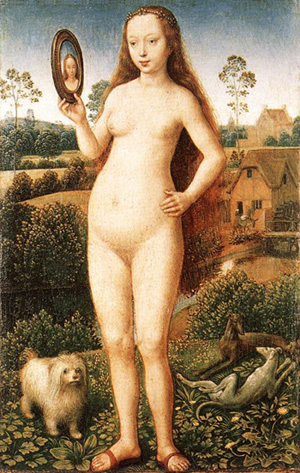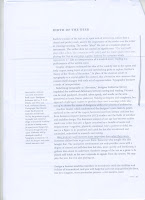"Advertising doesn't sell things; all advertising does is change the way people think or feel" (Jeremy Bullmore). Evaluate this statement with reference to selected critical theories.
The term 'advertising' and 'advertisement' have at their root from the Latin word 'advertere' meaning turn towards. Wright 1996 (page 4) defines advertising as follows: 'making it publicly known that an individual or an organisation has benefits, usually products and services, it wishes to offer to an identified target audience in return for some other benefit, usually money'
Advertising is all around us and although we don’t consciously realize it, it attempts to alter how we perceive ourselves or to modify our behaviour. To have an effect the advertisement must engage us with a common language and an emotional response. The whole point of advertising is to capture our attention and to change the way we feel so that a product can be sold or change product allegiance. It is very much a part of everyday life and often adverts hit us from every possible angle. New ideas, innovations come about through human interaction and discussion, so that great thinkers in one generation build from previous generations. Consequently advertising often uses images from former times to manipulate the impression of familiarity to a product.
Advertising encourages the consumer to invest in products using images that we feel can change our lifestyle or our lives by potentially buying more. By using gestures and signs our minds feel a need for what we are being sold, because of the lifestyle associated with it. John Bergers 'Ways of Seeing' gives a deep analysis of publicity within advertising and explains that adverts are directed and aimed at individual people rather than a large audience. As people we understand that 'You are what you have' (John Bergers Ways of Seeing Part 1).
I think many advertisements work in a very subliminal way and for what could be a split second looking at a poster on a wall, the language and images used almost trick you into thinking a different way without even realising. We long and hope to achieve more each day than we did the last and publicity plays on this, giving us an outcome which we eventually hope to reach. 'Publicity is different, it appeals to a way of life we aspire to or think we aspire to but have not yet achieved.' (Bergers Ways of Seeing Part 2, 1972)
Contrary to John Bergers outlook on advertising the characteristics of adverts and the way they work can be decoded in a completely different perspective, 'most people don't believe, don't remember, don't even notice, most advertising. This has always been so and always will be so.' (Stephen Garey, How advertising works). Advertisements could be seen as just serving the purpose of selling a product not tapping into our brains and convincing us to buy. Stephen Garey also states that 'The vast majority of advertising is ineffective and inefficient' but if this was the case then we wouldn’t live in the materialistic world that is today. Advertising and adverts are put out there to do a job, that job is to sell something, but it’s the way we personally understand what we see that changes the way we think.
To establish how we think or feel when we view an advertisement we need to understand the theory behind how adverts work. 'Its not what our message does to the reader, but what the reader does with our message, that determines our success' (Mackay, in Aitchison, 1997, page 25 Cutting Edge Advertising). This expresses that we decide what we think about an advertisement, not the advertisement forcing us to change the way we think. However Mackay also states “We want people to absorb what we're saying without being distracted by their own opinions” (Page 24 Cutting Edge Advertising) This refers to the way adverts are presented, how the way we think and feel is altered through the message that is being delivered. We may not realise but advertising shows us an alternate way of life that is briefly taken in and from then on as individuals decide our future.
Therefore adverts could be argued to change both the way we think and feel how we digest what we view just depends on our own personal characteristics and what appeals to us as a specific person.
To change the way we think or feel an advertisement should contain a deep underlying message that everybody can relate to. Communicating a message that stays in the viewers mind giving more time to understand what has been seen. Advertising has to pin point subjects which we can distinguish personally and this is the key factor to changing how we feel and think. The advert to the left was produced in 1969 by the Cramer Saatchi advertising agency made for the Health Education Council to educate people about unwanted pregnancies. 'Using the classical technique of turning the rational world on its head to demand attention........also using humour to great effect rather than a direct command or criticism which would have been more like to alienate the target audience and alleviate the problem' (Saunders Page 155) At the time most people thought the advert to be quite offensive and shocking due to contraception being a taboo subject to present in public and the image of the man being very far from a stereotype masculine image.
So the advert worked because of its shock tactics and the way everybody can understand the message that it’s putting across. Relationships and emotions are something everybody experiences in their lifetime so immediately you feel like you have a connection with the message. The advert is aimed at men. The statement: 'Would you be more careful if it was you that got pregnant?' highlights to male viewers the responsibility they hold in regards to a pregnancy. By questioning the viewer you are immediately getting them to think on impulse, therefore attempting to change the way they feel. This advert isn't trying to sell a product to the viewer instead it’s selling a message to the viewer altering their state of mind. 'For adverts to work, they must use our commonly shared resources of language in ways that affect us and mean something to us.' (Angela Goddard: The language of Advertising page 4). This statement re-enforces that the language and image in the poster above has been used as a common boundary for people to associate with. By using a Helvetica typeface, a typeface that is very bold and readable this adds to the way the message sticks in the audiences heads, Saunders Page 155 states: 'Although the headline is long the image is sufficiently intriguing to draw the viewer in to understand the message, the words and picture together add up to more than the sum of the parts.'
As previously stated Stephen Garey suggests that 'The vast majority of advertising is ineffective and inefficient.' This advert however would appear to have been very effective and efficient and became world famous by inclusion in 'Time Magazine.'
United colours of Benetton further developed the use of shock images in advertising, by using real images from the real world to 'be noticed and be remembered' (Saunders page 72), rather than imaginary imagery. Benetton connects with its audience on a different level to other advertisers by advertising their company rather than their actual products. Their ‘shock’ adverts confront issues such as birth, death, Aids, poverty and multiculturalism. In order to connect with a wider global audience. Perhaps the most memorable image being the 1991 photograph of a new born baby. The public tending to buy from a specific company because they favour and trust them over others. Benetton, by completely removing the whole sense of purchasing from their adverts, are instead trying to gain the trust of the public so that they are 'noticed and remembered.' Luciano Benetton: 'We believe advertising can be used to say something besides selling a product- something more useful' (Saunders,1992, Page 73). This shows that Benetton are attempting to change the way people think and feel, helping Benetton to become such a successful business. This unusual approach to marketing and advertising attempts to push the boundaries of imagery and controversy by highlighting subjects that relate to the Global Community with a universal Global brand. Benetton's advertising philosophy being the total opposite of the model proposed by John Bergers ('Ways of Seeing') of direct adverts targeted at individuals rather than a large audience. The Benetton poster of the baby changes how the public perceive the company. Benetton is trying to express a deeper message.
All advertising attempts to change our perceptions and alter our thought processes, encouraging us to do things we never would of thought of doing before by modifying our behaviour or lifestyle. Our feelings, emotions, opinions can all be subtly influenced by advertising attempting to alter our decision making process. Advertising changes both the way we think and feel on a range of different levels, when looked at in depth we can often read into it more than what is superficially visible.
An advert will simply only change the way you think, if you let it.
Bibliography;
Books;
Ray Wright. Financial / Times Prentice Hall 2000, ISBN 0-273-63289-2
Jim Aitchison. Cutting Edge Advertising / Prentice Hall 2004, ISBN 981-244-557-9
Angela Goddard. The language of Advertising / Routeledge 1998, ISBN 0-415-27803-1
David Saunders. 20th century Advertising / Carlton Books London 1999, ISBN 1-85868-520-6
Online Resources;
An article on how advertising works written by Stephen Garey:
http://www.medialit.org/reading-room/brands-r-us-how-advertising-works
John Bergers Ways of seeing 1972 BBC series:
http://www.youtube.com/watch?v=6q0JvXiZw7o&feature=related
A scanned image of page 26 of The Journal of Marketing 1999 explaining the linking between advertising and the consumer:
http://www.jstor.org/pss/1251999
A reference to 1969 Satchi Advert, 'Would you be more Careful' explaining a brief account on its background:
http://collections.vam.ac.uk/item/O102634/poster-would-you-be-more-careful/





















